
The Senate Armed Services Committee voted 22 to 3 on a bipartisan basis in favor of the current year National Defense Authorization Act, which includes a provision for requiring women to sign up for the national draft via the Selective Service.
Why? The bill’s executive summary does not provide any stated reason, but ostensibly, the reasons given for doing so in past years’ proposals have merely centered around issues of equity and sexual discrimination and whether it’s fair if only men are drafted, or that women would be excluded from the draft.
But another issue might have to do with the population of fighting aged men 18-to-24, currently 15.1 million, according to the latest data from the U.S. Bureau of Labor Statistics, accounting for about 4.5 percent of the total U.S. population of 335.2 million as of 2023 per U.S. Bureau of Economic Analysis data.
That’s not much better than the 14 million seen in 1980, when the male population aged 18-to-24 as a percent of the population peaked at 6.19 percent, back when the population was just 230 million.
Meaning, although the U.S. population has increased by 115 million since 1980, the population of fighting aged men has only increased by 1.1 million, as the number of 18-to-24-year-old men as a percent of the population declined from 6.19 percent to 4.5 percent.
When compared to potential adversary nations such as China, where conflict in Taiwan or the Koreas or Japan could break out any day, the potential size of U.S. fighting forces of able-bodied, young men is considerably dwarfed.
In China, there are about 102.3 million 18-to-23-year-olds, of which about 51 percent are male. And that’s with the one-child policy in effect there since 1980. That means there are about 52.2 million fighting aged men in China, compared to just 15.1 million in the U.S.
In the U.S., without any laws requiring less than two babies per woman, the FDA’s 1960 approval of birth control has nonetheless resulted in less than population replacement birth rates as more and more women have entered the labor force, attended college and opted either to not get married or not have children at all, with the numbers still plummeting, from 3.65 babies per woman in 1960 to 1.61 babies per woman in 2023.
If the U.S. had maintained more robust birth rates, the population might be more than 520 million today, and the number of fighting aged men would be considerably larger, more like 23 million. That’s still less than China, but it also underscores that the current prolonged demographic deficit of fewer marriages and fewer babies may in fact pose a real and present danger to national security not easily offset even with immigration.
Either way, in a hypothetical conventional war of attrition where the draft was employed by both the U.S. and China, China would have a considerable advantage in terms of wearing down personnel, since theoretically it could withstand more than triple the losses U.S. forces could.
Such a conflict might seem unlikely with the U.S. nuclear deterrent, on one hand, but on the other, mutually assured destruction might make a conventional war more likely if neither side was willing to go nuclear for fear of retaliation and national or global destruction. In any event, such a conflict might start out conventionally but ultimately come down to the use of nuclear weapons if it looked like one side or the other was losing.
That said, even if such a war was unlikely, the presence of nuclear weapons might not be enough to deter such a conflict from beginning. If U.S. armed forces were to employ a draft of both men and women, the pool of potential recruits would jump from 15.1 million to 30 million, with 14.9 million females aged 18-to-24 as of 2023.
That’s still 20 million less than simply the number of men China could potentially deploy if necessary, and still more than 70 million less than the number of men and women China could deploy.
According to the CIA World Factboook, China has already similarly decided to put women into the military via conscription: “18-22 years of age for men for selective compulsory military service, with a 2-year service obligation; women 18-19 years of age who are high school graduates and meet requirements for specific military jobs are subject to conscription.”
All talk of equity aside, that appears to be a far more compelling rationale for expanding the draft in the U.S. and other Western countries, even if it is unstated. The fact is, in traditional wars of attrition, larger nations tend to prevail over smaller nations and in a war against China, the personnel deficit would pose a considerable challenge.
That means even enlisting women would likely not be enough to match simply the number of potential fighting forces China could muster for a conventional war, and would require the U.S. to team up with other countries via alliances if China were to ever become a global threat akin to Nazi Germany or the Soviet Union after World War II.
Given the global scale and the likely, eventual resort to nuclear weapons, such a conflict would certainly be undesirable, but if it did occur, assuming it did not immediately go nuclear, who has the most fighting men and women might be more important than the Senate currently dares to admit. All talk of equity aside, in wars numbers matter.
Robert Romano is the Vice President of Public Policy at Americans for Limited Government Foundation.







